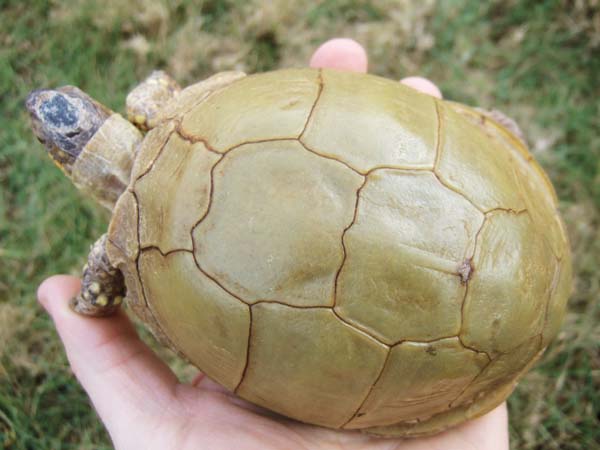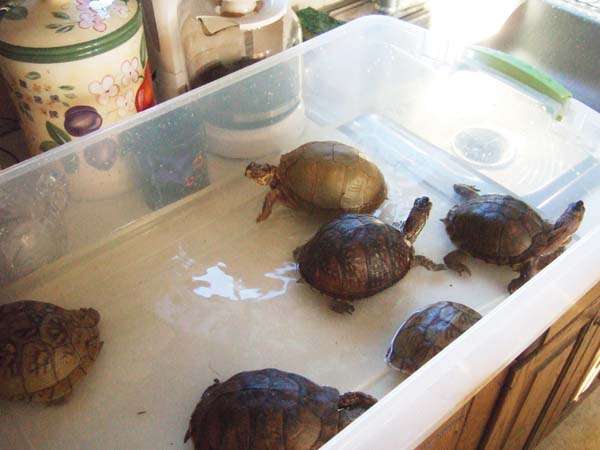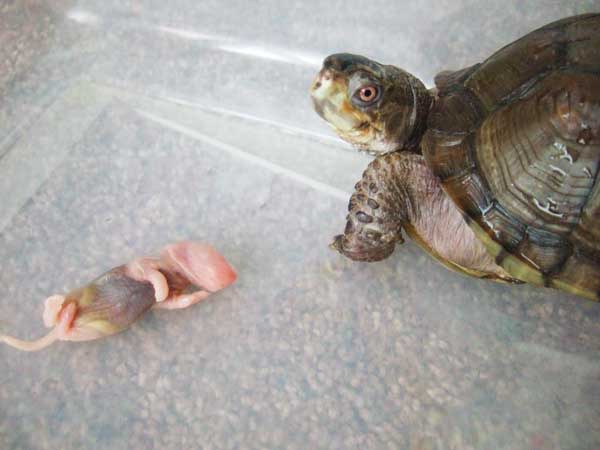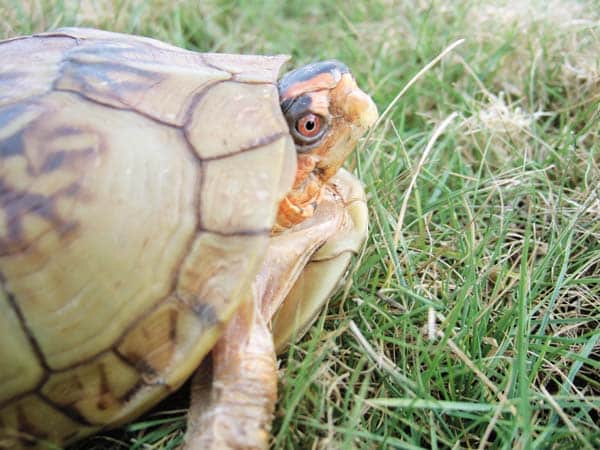Kept properly in an outdoor pen, the three-toed box turtle can thrive.
I remember, as a youth, observing a random assortment of turtles in a pet store and thinking, What’s wrong with that box turtle? It was my first encounter with the three-toed box turtle. Up until that point, I was familiar only with the beautiful and brightly colored eastern box turtles of Cape Cod in Massachusetts.

Photo by Leo Spinner
A beautiful example of T. c. triunguis.
I figured the peculiar olive-green, bland-looking creature must certainly have something wrong with it. It looked like a box turtle superficially, but where were the intense reds and yellows of its skin, and the brightly colored patterns on the shell? The box turtle I was looking at appeared as if some mysterious illness had drained the color right out of it. Yet among all of the other turtles in that tank, most of which were western box turtles, it was the one that stood out, and the turtle that went home with me that day.
Description and Natural History
The three-toed box turtle (Terrapene carolina triunguis) is a subspecies of the eastern or common box turtle (T. c. carolina). It shares sub-specific status with it and two others in the complex: the Florida box turtle (T. c. bauri) and the largest of the four subspecies, the Gulf Coast box turtle (T. c. major). Its peculiar sub-specific name, triunguis — it sounds like a Godzilla-fighting Japanese monster — refers to the three toes on the turtle’s rear feet, with tri meaning “in three,” and unguis meaning “claw.”

Photo by Leo Spinner
A large adult female three-toed box turtle.
The three-toed has a narrow range within the central part of the United States, from Missouri south to Alabama and west to east Texas. Like the other T. carolina subspecies, it is usually found in woodlands and grassy meadows, with individuals rarely wandering beyond a football field-sized territory.
It favors cool, damp weather and if the weather is warm and sunny, this diurnal turtle will often find a shady area in which to roam. It takes readily to shallow pools of water on a hot day, and to escape the heat, T. c. triunguis may also aestivate temporarily beneath accumulated forest leaf litter, under a fallen tree, or within an old stump hole.
Three-toed box turtles are most active during the spring, shortly after winter emergence, when the weather is rainy. This is when females search for nesting sites, and many turtles are killed each year while crossing busy roads. Daylight hours are spent searching for prey and entertaining members of the opposite gender during chance encounters. Breeding occurs throughout the active season, but peaks from April through July, when three-toed box turtles, biologically speaking, are at their reproductive best. In nature, females typically deposit eggs from May to June.
The smallest of the four T. carolina subspecies, triunguis rarely grows beyond 5 inches, with large females reaching 7 inches in total length. It shares the three-toes-on-the-rear-feet trait with the Florida box turtle (the eastern and Gulf Coast box turtles both have four). Some triunguis have been found with four toes on the rear feet, though these may be intergrades where its range overlaps with other Terrapene species.
Compared to other box turtles, the three-toed box turtle is not very colorful. The carapace is usually a solid olive green, brown or yellow, though it may occasionally include light spotting or striations. There is a single hinge on the yellow plastron. This hinge is the reason for the common name “box turtle,” in that it allows box turtles to completely close themselves within their shells as a defensive maneuver. A box turtle can close so tightly, it would be difficult to pass a blade of grass between the carapace and the plastron!
There is some sexual dimorphism. Most male three-toeds have red eyes and a concave plastron; females generally possess green eyes and a flat plastron. Males have larger, curved rear nails, which aid in copulation, and longer, thicker tails than females, though females, as mentioned, tend to be larger in overall size. They also usually have plainly colored skin with occasional light spotting on the face and/or legs. Males usually have more brightly colored faces, exhibiting red, orange or a combination of bright red, white and black.
A High-Priced Pet
The three-toed box turtle was standard pet store fare throughout the 1970s and 80s. Perhaps due to its relative abundance in nature or the minimal amount of bright coloration it exhibited, it was relatively inexpensive and an easy sale. Now things are a little different, and this gentle box turtle has developed a bit of a cult following. When they are available, three-toed box turtles fetch a much higher price than they used to. Captive-born babies often sell for about $100.

Photo by Leo Spinner
A shallow bath twice a week should be provided to specimens kept indoors.
The ideal captive environment for a three-toed box turtle is one that is outdoors. It needs a lot of space because, like all box turtles, T. c. triunguis likes to roam around in search of food. Outdoor enclosures can be constructed using 2-by-10-inch planks, held together with lag bolts firmly anchored into pressure-treated 4-by-4s on each corner. An outdoor enclosure measuring 10 by 12 feet can house several adults comfortably. With triunguis, there will sometimes be male to male combat during the breeding season if enough receptive females are not available. This is non-aggressive combat however and the enclosure size of 10 by 12 feet will provide ample room for subordinate males to simply “walk away.” Two males to every four females will work well.
Although triunguis is an accomplished digger, individuals don’t generally attempt to dig under and out of their pens. To play it safe, some keepers sink the walls of the enclosure several inches into the soil.
If you keep three-toed box turtles outside, you will eventually notice that individual turtles will return to specific locations in which they sleep each night. When a preferred area is chosen, they will often excavate a small sunken area in which they will feel secure. If the enclosure does not have a secure screened cover placed over it, I recommend equipping it with a lock box or plastic tote in which to place your turtles at night. Box turtles are easy prey for marauding raccoons, coyotes and other predators, as well as nocturnal rodents such as rats and flying squirrels, which may gnaw on box turtle shells for the calcium benefits and to help file down their teeth. A secure cover over the pen will also keep out pets such as dogs and cats, as well as inquisitive children. Three-toed box turtles are small and easy for toddlers to pick up, and they may not always be put back down in their enclosures!
My box turtle enclosures are located against the side of my house. Having them there provides the turtles some protection against the elements while also making them easy to observe from inside the house. Enclosures constructed close to your home may also help deter some predators. They should also be heavily planted with native plants, which will provide a great deal of shade (remember, these turtles like shade and cooler temperatures) as well as some filtered sunlight. I use pokeberry (Phytolacca), which grows extremely dense and is abundant here in Cape Cod. Pokeberry plants have a semi-tropical look to them and genuinely enhance an outdoor turtle garden.
Be sure to include a shallow pool in your box turtle enclosure. Three-toed box turtles are fond of sitting in shallow water, especially during hot summer days. Plus, the water will attract insect prey the box turtles will feed upon. Turtle pools can be constructed using a rubber garden pond liner placed in a shallow hole, or concrete can be placed in the hole, smoothed with a paint brush prior to drying, then painted with a heavy-duty waterproofing paint. If this sounds complicated, a turtle pool can be constructed by sinking an upside-down garbage can lid into the ground much more easily!
Keeping box turtles outdoors also allows you to naturally cycle them for breeding, should you desire to try breeding them, and you will also eliminate much of the negative effects associated with keeping them indoors, including overgrown nails and possible respiratory infections. You will benefit greatly by watching your turtles behave as they would in nature.
The Three-Toe Box Turtle Diet
Feeding pet triunguis is never a problem with animals kept under optimal conditions. They are ravenous feeders that will eat virtually any type of animal protein, as well as plant material. They will readily accept live insects, such as roaches and mealworms, as well as small pre-killed mice and commercial turtle foods.

Photo by Leo Spinner
Three-toed box turtles should be offered whole food animals, such as pink mice from time to time.
Pay close attention to what your individual turtles are eating, especially if they live in an outdoor enclosure. Natural feeding can be encouraged by attracting invertebrates to the enclosure. One way to do this is by maintaining a small compost pile within the enclosure, and covering it with a section of tarp or burlap. Worms and other invertebrates will be attracted to this nutrient pile, and they will in turn be hunted by your box turtles. Keep in mind that a compost pile may also invite unwanted vermin to an uncovered enclosure; another good reason to keep a secure cover over the box turtle pen.
Although they will catch and eat an assortment of garden insects and night crawlers, feeding your turtles in a separate container or enclosure will help assure that they are receiving enough of the right types of foods for proper growth and development. I feed my box turtles daily, and they are given a variety of insects, fruits and vegetables, and frozen/thawed hopper mice. Feeding box turtles whole animals such as mice also helps with the natural wear of the beak. Calcium/vitamin supplementation is not necessary when keeping box turtles outdoors, as long as they receive exposure to natural, unfiltered sunlight.
Breeding Boxes
Captive breeding of three-toed box turtles can be easily achieved, especially with turtles that are kept outdoors within their natural range, or in an area that experiences a similar climate.
Toward the end of summer, use a mulching fork or shovel to turn over the soil around the inside perimeter of the turtle enclosure, down to a depth of at least 12 inches. Yard refuse, such as raked leaves, pine needles and grass clippings, should be placed over areas where the soil has been turned over. This will provide suitable hibernating areas for your turtles, which they will begin looking for when nighttime temperatures begin to drop below 50 degrees Fahrenheit.
While hibernating, the turtles will remain out of view for several months until warm spring rains thaw the ground and awaken them. Depending on where you live, you may see them as early as March or as late as late-April. Once they have emerged and have been active for several weeks, females will begin looking for suitable nesting areas.
Although you may not have witnessed actual copulation, it is likely that your female was breeding throughout the previous spring and summer. It is also possible for females that have not bred for as long as four years to still lay viable eggs, due to sperm retention. When a male three-toed box turtle is interested in a receptive female, he will often circle her, sometimes biting at her face and shoving her. Other times males will approach females from the front and inflate their necks. After a courtship that may last up to an hour, the male will attempt to mount the female by climbing onto her back and gently scratching at the front of her carapace. A receptive female will then lower the posterior part of her plastron, allowing the male to hook his large curved claws beneath her carapace, at which time she will close her plastron on his nails. This prevents him from falling off as he leans back into an upright or even reclining position during copulation, which may last as long as an hour or two before the male is released to go about his business.
Gravid females seek warm, moist areas in which to dig their nests, in which they will lay three to five eggs. Nest digging is accomplished using the rear feet and may take a female several hours to complete. If she is attempting to dig a nest in soft sand, she will sometimes urinate into it to prevent the nest from collapsing during construction. Once the eggs have been deposited, a female three-toed box turtle will go to great lengths to ensure that the nest is completely hidden from view.
Eggs incubate successfully between 84 and 88 degrees Fahrenheit, and on average take about 70 days to hatch. Hatchling triunguis enter the world in a rather plain package of gray or brown, often with a light yellow spot on each scute of the carapace. Babies should be collected and reared under more controlled conditions indoors, maintained at temperatures between 79 and 82 degrees in a terrarium containing a quarter of an inch of fresh water and a dry area for the turtles to climb on. Neonatal box turtles dehydrate quickly and must be provided with fresh water at all times.
Baby turtles should be provided an assortment of size-appropriate food items daily, and these items should be dusted with a good-quality calcium/vitamin D3 supplement a couple times a week to ensure proper hardening of their shells. Full-spectrum lighting should also be provided over their enclosure, and young turtles should be exposed to natural unfiltered sunlight outdoors as often as possible, to enable proper growth and development.

Photo by Leo Spinner
Walking through grass can be quite a chore for a baby box turtle.
The keeping of any type of box turtle, including T. c. triunguis, should not be taken lightly. Box turtles should not be kept by anyone but the most dedicated of caretakers. I do believe, however, that if you decide to undergo the adventure of keeping these wonderful turtles, you will be heavily rewarded with years of fond memories.
LEO SPINNER resides on Cape Cod in Massachusetts and in southeastern Pennsylvania with his children. He owns Skin and Scales exotic reptile presentations (skinsandscales.net), as well as The Spotted Turtle Herpetological Institute of Cape Cod.



